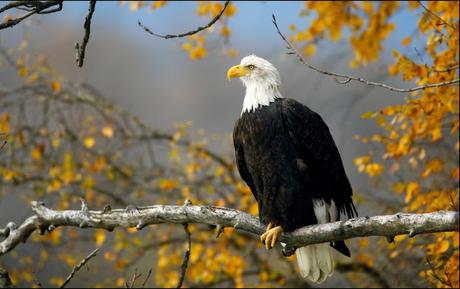 (Photo of the Bald Eagle, from PBS NewsHour, is by Bob Strong/Reuters.)
(Photo of the Bald Eagle, from PBS NewsHour, is by Bob Strong/Reuters.)Beyond his own ego, there's only one thing Donald Trump believes in -- helping the corporations and the rich to make obscene profits. And he doesn't really care who is hurt in the process.
He has gutted our environmental laws (put in place to protect our land, water, and air for the good of all citizens) so corporations don't have to spend money protecting the environment or clean up after they pollute.
Now he is attacking another area, so corporations can make more money without considering their impact on the environment -- the Endangered Species Act. This act has been remarkably effective in protecting wildlife facing extinction -- including our national symbol, the Bald Eagle.
Trump doesn't care. Obscene corporate profits are more important than endangered species to him.
Here's part of an excellent op-ed on Trump's latest misadventure by ecologist Dr. Carl Safina in The New York Times:
Some 1,650 species of animals and plants in the United States are listed under federal law as endangered or threatened. But when they are reduced to a line item on a list, their multimillion-year existences and roles in the complex living communities that include humans become invisible. Each minor species, whispering its testimony quietly from its corner, cannot make the larger class-action case, which is that, everywhere, trouble finds them. Now there’s more trouble. Until now, the principal existential threats to free-living species have included urbanization, expanding intensive agriculture, pesticides, plastics, river pollution, dams, invasive species and the three “overs”: overcutting, overhunting, overfishing. Now we can add to that list President Trump, his administration and complicit Republicans in Congress. The Trump administration has announced new rules that will significantly weaken the way the nation’s Endangered Species Actis applied, potentially opening the way for mining, oil and gas drilling and development that will undermine or doom components of our nation’s living endowment. The rules affect future listings and threaten to throw into reverse the enormous success over nearly 50 years of saving animals and plants from extinction and elevating their prospects. Unable to kill or neuter the act legislatively because of strong support for the law even in the Republican-held Congress of the first two years of his presidency, Mr. Trump now is eviscerating it by gutting regulations that make it effective. Perhaps most crucially, the rule diminishes “critical habitat” protections, like those for areas formerly occupied by now-endangered species, though such habitat is the only hope many depleted species have for eventual recovery. The rule is intended to impede the listing process and ignore declining habitat viability caused by climate change. And for the first time, a tally of financial considerations will accompany discussions on the fate of species. . . . It used to be that animals did not need us. Now they do. Unless we value their existence, the modern tide will engulf and obliterate them. Their survival — like our great-grandchildren’s — is a moral matter. No religion has ever preached that our role on earth is to destroy, or to leave less for those who’ll come after us. No wisdomtradition teaches that it’s O.K. for a generation to drive the world toward ruin. We are taught instead that we must safely pilot the ark. The tragedy of this situation is that the Endangered Species Act has been such an enormous success in the United States that it is the model for other countries around the world. Some turnarounds have been triumphs for large, much-loved species. Almost 80 percent of marine mammals and 75 percent of sea turtles that attained protection under the law have increased significantly. The California condor, the largest bird in North America, was so close to extinction in the 1980s that the remaining 20 or so in the wild were captured and bred for release. The program’s 1,000th condor chick recently hatched, and there are now some 230 free-flying birds in California, Arizona and Baja California. Bald eagles rocketed back from a DDT-devastated low of roughly 400 breeding pairs in the lower 48 states in the early 1960s to some 14,000 breeding pairs and 70,000 bald eagles of all ages south of Canada today. Now a common winter sight on the lower Hudson River within view of Manhattan, they’ve been off the list since 2007. Other recoveries enabled by the law have been so spectacular that it’s hard to imagine certain species as rare. These include brown pelicans, which increased by more than 700 percent in 40 years, and the American alligator, listed as endangered in 1967 and off the list by 1987. . . . And because of the Endangered Species Act, the United States has made possible much wildlife recovery work abroad, including sea turtle nesting protections that I’ve witnessed from the Caribbean to Indonesia, and many other projects. The things that threaten other species, threaten us. How could they not? Degradation of land, exhaustion of soil, sickening pollution of our water and air — when species become endangered it is because deeply systemic threats have become symptomatic. . . . For exerting our collective love of nature to protect and maintain plants and animals on the brink no more important or effective mechanism exists than the United States’ Endangered Species Act, which the Trump administration now seeks to torpedo. President Richard M. Nixon signed the law in 1973, saying: “Nothing is more priceless and more worthy of preservation than the rich array of animal life with which our country has been blessed.” Blessed, indeed. “America the beautiful” is our nation’s expression of moral gratitude for the most fortunate thing that unites our country from sea to shining sea. The Endangered Species Act is our legal recognition of the stewardship responsibilities of our dominion. To take it apart is to contribute to the thanklessness — one might say contempt — for what has made our nation great.

